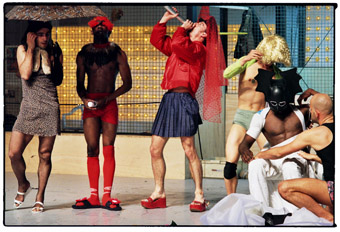forsythe, bausch, platel…
martin del amo: reeldance festival contemporary dance on screen

Les Ballets de Ci de La, Alain Platel
THE SCREENING PROGRAMS PRESENTED AS PART OF THIS YEAR’S REELDANCE FESTIVAL WERE GENERALLY STRONG AND, YET, ONE OF THEM CLEARLY STOOD OUT FOR ME: CONTEMPORARY DANCE ON SCREEN. A VERITABLE TREASURE TROVE FOR ANYONE INTERESTED IN CONTEMPORARY DANCE, IT BROUGHT TOGETHER THREE OF THE ART FORM’S BIGGEST NAMES: WILLIAM FORSYTHE, PINA BAUSCH AND LES BALLETS C DE LA B.
The program opened with One Flat Thing, Reproduced (Belgium/Germany, 26mins), a screen adaptation of William Forsythe’s work of the same title, originally created with dancers of the Frankfurt Ballet in 2000. Set in a vast industrial hall with natural light streaming in through large windows, it features 20 metal tables, amid which 17 dancers execute Forsythe’s extremely intricate and complex choreography, ranging from sharp-edged angularity to off-centre languidness.The piece is widely regarded as one of Forsythe’s masterpieces and acclaimed filmmaker Thierry de Mey has done an excellent job in translating it to the screen. His approach to filming is unashamedly subjective, his camera knows no boundaries and seems to be ubiquitous. It hovers above the tables at one moment and crawls beneath them in the next. It smoothly moves vertically but also frequently circles the action. With a camera of such flexibility, de Mey supports and reinforces the obsessively multi-directional choreography. At the same time, he offers the film’s viewers perspectives on the work that audience members at the live performance would never have.
In Pina Bausch (Germany, 45mins), a documentary on the grande dame of dance theatre, German filmmaker Anne Linsel has achieved something of a small miracle, managing to get the notoriously camera-shy Bausch talking candidly about her life and work with Tanztheater Wuppertal, the groundbreaking company she has directed for more than 30 years. Meticulously researched and masterfully edited, this film provides a comprehensive overview of Bausch’s achievements. Excitingly, it brims with excerpts from her shows, including the iconic scene from Nelken in which performer Lutz Foerster, clad in a tuxedo and standing on a stage covered with carnations, interprets the song The Man I Love in sign language. There is also an excerpt from Bandoneon (1982) with Australia’s Meryl Tankard at the height of her performative powers, repeatedly pushing the head of fellow dancer Nazareth Panadero into a bucket of water, all the while screaming, “Smile, Nazareth, smile!!!”
In addition to Bausch herself, the film also includes interviews with some of her longtime collaborators as well as many of her dancers, several of whom have been with the company for more than 25 years.
There is a lot of talk about trust between Bausch and her dancers. She admits to leaving them in the dark as to what exactly she is looking for during a rehearsal process and which bits of the generated material might make it into the show. One of her dancers sums up the relationship as resembling more a love affair than a work relationship. She then adds: “That causes a lot of pain.”
This film is a thoroughly fascinating document. It confirms Pina Bausch as a passionate artist of great creative and personal integrity and reveals the depth of the relationship between Bausch and her dancers, which has produced some truly stunning contemporary dance works in the last 30 years. At only 45 minutes, the film is a model of economy and restraint and left this viewer utterly satisfied.
The closing film, Les Ballets de Ci de La (Belgium, 55mins), celebrates the history of Belgium’s famous dance and theatre company Les Ballets C de la B on the occasion of their 20th anniversary. It was made by the collective’s founding member and key figure, Alain Platel. Integrating excerpts from shows with filmic portraits of some of the choreographers and dancers affiliated with the company, this insightful documentary sheds light on the socio-political context in which its work is created. In the most interesting sections of the film, Platel accompanies two of the company’s dancers as they return to their respective hometowns, small villages in Burkina Faso and Vietnam. In both cases, video footage of the dancers performing in Wolf (2003), a show directed by Platel, is shown to the dancers’ parents. It’s moving to see how they grapple with their sons having made a career for themselves in Europe, outside of the culture in which they brought them up. Pride is mixed with apprehension, a feeling shared by the sons, as Platel, in turn, shows the men coming to terms with their parents’ comments. Les Ballets de Ci de La powerfully confirms that it is the performers’ personal commitment, their thoughts, opinions and lives, that feed Les Ballets’ work that is internationally acclaimed for being deeply anchored in the everyday world with all its coarseness, imperfection and fragility.
Contemporary Dance on Screen, May 16, ReelDance International Dance on Screen Festival 2008, Performance Space, CarriageWorks, Sydney, May 11-18
RealTime issue #86 Aug-Sept 2008 pg. 35






